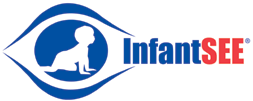
Children’s Vision
Children with uncorrected vision conditions or eye health problems face many barriers in life, academically, socially, and athletically. High-quality eye care can break down these barriers and help enable your children to reach their highest potential! As a parent, make sure you are giving your children the eye care they need.
Infant’s Vision
Newborns have all the eye structures necessary to see, but they haven’t learned to use them yet. Infants’ vision begins to develop at birth. Babies spend much of their early weeks and months of life learning how to see- developing such skills as focusing, teaming their eye movements, recognizing depth, developing eye-hand coordination, and making spatial judgments. As the child grows, more complex skills, such as visual perception and visual motor integration, develop to meet the child’s growing need to understand and interpret his world.
During the first four months of life, your baby should begin to follow moving objects with the eyes and reach for things, first by chance and later more accurately, as hand-eye coordination and depth perception begin to develop.
At about age six months, you should take your baby to your doctor of optometry for his or her first thorough eye examination. Things that the optometrist will test for include excessive or unequal amounts of nearsightedness, farsightedness, or astigmatism and eye movement ability as well as eye health problems. These problems are not common, but it is important to identify children who have them at this stage. Vision development and eye health problems can be more easily corrected if treatment is begun early.

InfantSEE
Through the InfantSEE program, Complete Family Eyecare will provide a one-time, comprehensive eye and vision assessment to infants between 6 and 12 months of age, offering early detection of potential eye and vision problems at no cost regardless of income.
- Vision eye problems can occur without any noticeable symptoms.
- 1 in 10 children is at risk of developing eye and vision problems by the time they reach 18.
- Up to 5 percent of America’s preschoolers-nearly 4 million children, or up to one in every 20 nationwide-have impaired vision.
- Many of these children have a problem that can be prevented or easily corrected if it is caught early.
- A vision screening by your pediatrician is not a substitute for a complete eye health and vision evaluation.
Click here to visit InfantSEE Online for more information.
Pre-School Vision
During the infant and toddler years, your child has been developing many vision skills and has been learning how to see. In the preschool years, this process continues, as your child develops visually guided eye-hand-body coordination, fine motor skills and the visual motor skills necessary to learn to read.
As a parent, you should watch for signs that may indicate a vision development problem, including a short attention span for the child’s age; difficulty with eye-hand-body coordination in ball play and bike riding; avoidance of coloring and puzzles and other detailed activities.
By age three, your child should have a thorough optometric eye examination to make sure your preschooler’s vision is developing properly and there is no evidence of eye disease. If needed, your doctor can prescribe treatment including glasses and/or vision therapy to correct a vision development problem.
Here are some tips to make your child’s optometric examination a positive experience:
- Make an appointment early in the day. Allow about one hour.
- Talk about the examination in advance and encourage your child’s questions.
- Explain the examination in your child’s terms, comparing the E chart to a puzzle and the instruments to tiny flashlights and a kaleidoscope.
Unless recommended otherwise, your child’s next eye examination should be at age five. By comparing test results of the two examinations, your optometrist can tell how well your child’s vision is developing for the next major step…into the school years.
School-Age Vision
A good education for your child means good schools, good teachers and good vision. Your child’s eyes are constantly in use in the classroom and at play. So when his or her vision is not functioning properly, learning and participation in recreational activities will suffer. The basic vision skills needed for school use are:
- Near Vision: The ability to see clearly and comfortably at 10-13 inches
- Distance Vision: The ability to see clearly and comfortably beyond arm’s reach
- Binocular Coordination: The ability to use both eyes together.
- Eye movement skills: The ability to aim the eyes accurately, move them smoothly across a page and shift them quickly and accurately from one object to another.
- Focusing skills: The ability to keep both eyes accurately focused at the proper distance to see clearly and the change focus quickly.
- Peripheral awareness: The ability to be aware of things located to the side while looking straight ahead.
- Eye/hand coordination: The ability to use the eyes and hands together.
If any of these or other vision skills is lacking or does not function properly, your child will have to work harder. This can lead to frustration, headaches, fatigue and other eyestrain problems. As a parent, be alert for symptoms that may indicate your child has a vision or visual processing problem. Be sure to tell your optometrist if your child frequently:
- Loses their place while reading
- Avoids close work
- Holds reading material closer than normal
- Tends to rub their eyes
- Has headaches
- Turns or tilts head to use one eye only
- Makes frequent reversals when reading or writing
- Uses finger to maintain place when reading
- Omits or confuses small words when reading
- Consistently performs below potential
Since vision changes can occur without you or your child noticing them, your child should visit the optometrist at least every two years, or more frequently, if specific problems or risk factors exist. If needed, the doctor can prescribe treatment including eyeglasses, contact lenses or vision therapy.
Remember, a school vision screening or pediatrician’s screening is not a substitute for a thorough eye examination.

Youth and Their Eyewear; At all ages but specifically for our youth, eyewear is very important for their protection.
We offer children the latest technology, tailored to their specific needs for a wide range of activities and sports.
Protective Eyewear
Please don’t overlook the importance of safety eyewear when playing sports. Prevent Blindness America reports that hospital emergency rooms treat 40,000 eye injuries every year that are sports-related. To help prevent sports eye injuries, athletes should use protective athletic eyewear – this is whether or not prescription eyewear is needed. One choice is a sports frame with prescription or non-prescription polycarbonate lenses.
Children and Sunglasses
Sunglasses are essential for protecting eyes from sun damage, they also improve vision. Sunglasses are important for people of all ages. Many experts believe our eyes get 80 percent of their total lifetime exposure to the sun’s UV rays by age 18. And since excessive lifetime exposure to UV radiation has been linked to the development of cataracts and other eye problems, it’s never too early for kids to begin wearing good quality sunglasses outdoors.
Children and Contact Lenses
It is very important for children who wear contact lenses (and their parents) to remember that contacts are prescribed medical devices. There are some risks involved in lens wear, including infections, allergic reactions, eye dryness, redness or irritation. If contact lenses are not cared for properly they can lead to permanent vision loss. It is extremely important that the lenses be properly cleaned and worn according to the instruction of the optometrist.
Thanks to technological, medical and cosmetic advances in contact lenses, more parents are switching their children’s glasses with contacts. Children often want contacts for many of the same reasons adults do, including appearance, comfort and improved vision. Children may benefit from contact lens wear more often than we think.
Children’s vision is constantly developing, and contacts give a more “real” or less distorted view of the world. Contact lenses can balance the image from both eyes, and correct any irregularities or astigmatism of the eye. Some studies have also shown that progression of nearsightedness can be lessened by contact lens use. Contacts are an excellent option for the budding athlete as well.
Contact lenses are designed to fit each individual, no matter what age, so fitting your child should be no more difficult than fitting an adult. Your eye care provider can help you make an informed decision as to whether contacts are right for your child.
It is important to know whether your child is suited for contact lenses. Indications may include medical or cosmetic reasons, whereas eye health, cost, allergies, and parental responsibilities may indicate that contacts are perhaps not best for your child. However, by staying with the prescribed care regimen and having good follow-up and communication with your eye care provider, most complications are rare. You know your child and what they are capable of- please let us know if you would like your child to try contact lenses today.
